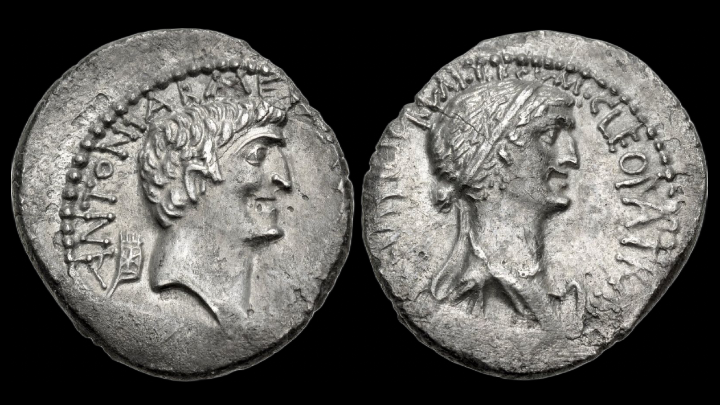ome coins encapsulate a pivotal moment in ancient history all by themselves. The joint denarius of Mark Antony and Cleopatra, struck in 34 BC, is unquestionably one of them. It symbolizes the union of East and West, the growing tension between Rome and Egypt, and—above all—the most mythical couple of Antiquity.
This denarius is remarkable not only for its imagery but also as a piece of propaganda issued on the eve of war with Octavian (the future Augustus). For collectors, it is an exceptional object that combines rarity, symbolic power, and aesthetic quality—a benchmark piece in any numismatic collection.
The Coin: Two Portraits, Two Worlds
This silver denarius was most likely struck in Alexandria in the autumn of 34 BC. It measures 18 mm and weighs 3.27 g. Die axis: 12 o’clock. It shows a light, glossy patina, some cleaning marks, moderate porosity, and a small flan crack, yet still grades Very Fine (VF).
Obverse. Bare-headed portrait of Mark Antony facing right, with the legend ANTONI • ARMENIA DEVICTA (“Mark Antony — Armenia conquered”). To the left of his profile appears an Armenian tiara, recalling his recent victory in that region and underscoring his military role and strategic legitimacy.
Reverse. Diademed, draped bust of Cleopatra facing right. At the truncation of the bust is a ship’s prow—symbol of Egypt’s maritime power. The surrounding legend CLEOPATRAE REGINAE REGVM FILIORVM REGVM proclaims, “Cleopatra, queen of kings and of the children of kings,” a bold formula that asserts her autonomous royal status and the dynastic succession of the Ptolemies.
This mirror-image pairing of a Roman and an Egyptian ruler in a single coin issue is unparalleled for the period.

History: Propaganda, Civil War, and Imperial Destiny
The striking of this denarius took place in a highly charged political climate. Mark Antony had just completed a campaign against Armenia and, in Alexandria, staged the famous “Donations,” granting eastern territories to Cleopatra and their children. In Rome these acts were seen as treason, fueling Octavian’s propaganda that Antony sought to shift Rome’s power to Alexandria.
The denarius was thus a weapon in an image war, where political legitimacy was also contested through coinage. The couple was at its zenith—but downfall loomed. In 31 BC Octavian defeated them at the Battle of Actium; the following year, Mark Antony and Cleopatra took their own lives, and Egypt became a Roman province.
This coin therefore bears witness to the final surge of Egyptian independence, the end of the Roman Republic, and the imminent birth of the Empire under Augustus.
A Bridge Between Two Worlds
The denarius of Mark Antony and Cleopatra is an extraordinary piece. Through its portraits, legends, and historical context, it embodies one of history’s most celebrated relationships and a decisive turning point in the destiny of the Mediterranean world.
This splendid specimen realized a price of $14,000.
If you’re looking for this coin, just ask—we’ll find it for you.